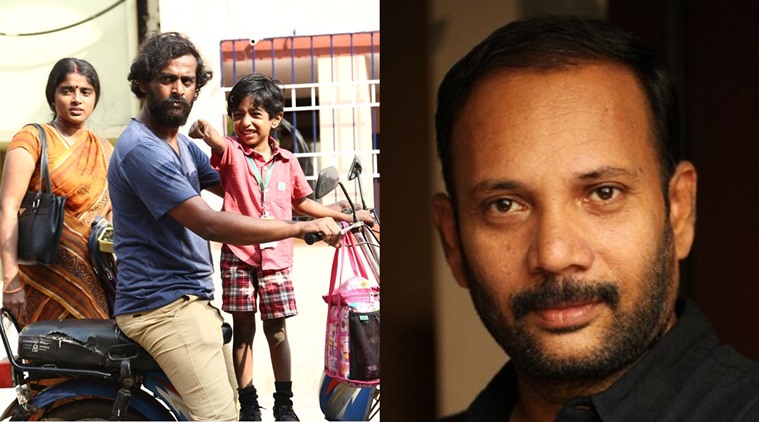
Chezhiyan doesn’t want to have limitations when it comes to the kind of films he makes. Though To Let isn’t exactly a big film in terms of budget, the cinematographer-director admits he didn’t want it to remain small in its reach or impact. “I have always been clear that I wanted to make ‘realistic films’ without any big names involved. So, I tried my best to get To Let to as many film festivals as possible,” he says.
It was 2007 when the idea of To Let struck him. “We had to shift houses, and Chennai was new to me. In fact, I saw the other face of the city and started writing down my experiences in a diary. I met different people and they asked me different questions including my caste, what I believed in and so on. I realised I had a story there. I used to write a column ‘Ulaga Cinema’ in a popular Tamil magazine. Those experiences also came in handy,” he smiles. Initially, Chezhiyan was planning to write To Let in the form of a novel, but never thought he would convert that into a script. “But the finished one was about 150 pages long. I had to revisit whatever I had written in 2007 and made drastic changes. Because I knew I was making a film for the audience who consume Netflix and Amazon Prime. I need to get them to theaters, and that’s possible only with an effective storytelling approach,” he says.
Chezhiyan entered the film industry to become a director, but couldn’t make films immediately. Instead, he took up cinematography. His first film as a Director of Photography was Balaji Sakthivel’s Kalloori. Then, he went on to work in critically-acclaimed films including Thenmerku Paruvakaatru, Paradesi and Joker. “But a director isn’t much different from a cinematographer,” he observes, and adds, “While a director has his own vision, a cinematographer understands and complements a director’s vision.” He says if not for Rudraiah (director of Aval Appadithaan) he wouldn’t have become the person he is today. “He was the one to insist that I learn cinematography. I eventually joined PC Sreeram sir. Until then, I didn’t know who Krzysztof Kieślowski, Ingmar Bergman, Andrei Tarkovsky, Robert Bresson and Mrinal Sen were,” he says.
Growing up watching the films of CV Sridhar and Balu Mahendra, Chezhiyan, naturally, didn’t want to make a regular commercial film with the hero doing stunts or a heroine dancing around trees. “That doesn’t mean To Let isn’t a commercial film. Anything that involves money is commercial. I wrote To Let only for the festival audience and my sole intention was to take Tamil cinema to the international scene because there are very few representations for Tamil films in major International film festivals. Tamil cinema is yet to make its presence fully in the global scenario,” he tells us.
Attending film festivals has immensely helped Chezhiyan in gaining exposure. “I learned that Iranian directors make films with a budget of Rs 7 lakh. What surprised me was they shoot with handycams. Say, there are a bunch of six people at the shooting spot—everyone does everything. One actor doubles up as an assistant director and coordinates with the shots. The other one cooks for the crew. Everyone works as equals and make a film unlike what happens here,” he adds.
Chezhiyan says he realises being selected at festivals doesn’t mean a film will work commercially. “It’s more about striking a chord with the audience. This concept of house-hunting is something everyone can relate to—from Bombay to Berlin. As soon as we were done with the shoot, I took my film to many producers, but they wanted me to include a song and change the climax. I don’t understand why producers think only larger-than-life stories make money. My wife suggested that we produce To Let ourselves. Anything that touches your heart is good cinema. I knew I had directed one,” he adds. Chezhiyan jokingly says his journey is similar to his protagonist, Ilango. “He was in search of a house and I was in search of a producer,” he laughs.
Slowly, our conversation veers to his decision of doing away with songs and the background score for To Let. “Tamil cinema and music are intertwined. As an audience, we are used to watching films with a minimum of five songs. But once you move closer to realistic cinema, the first component that makes an exit is music. Moreover, I thought the ambient noise would suffice because I knew I could convey a story without any distraction. This doesn’t mean I don’t like music. I pretty much do. The story has to be a priority for any good filmmaker, and if you consistently watch good films, you will understand what I am talking about. First of all, we should stop making films keeping the opening weekend and box-office collections in mind. Also, it is high time we stopped hero-worshipping in Tamil cinema,” he smiles.
Chezhiyan admits that he is living his dream. “It is exhilarating to find that we, as a team, were able to convey what we had wanted to without compromises. I had cast new faces and that additionally helped. The protagonist, Santhosh Sreeram was my camera assistant and I remember he would stand before the camera when I needed to test the light. Surprisingly, the biggest compliment came from PC Sreeram sir. He was one of the first people to watch To Let and liked it. He told me he hadn’t watched such a lighthearted film in the recent past. That meant a lot to me,” he signs off.